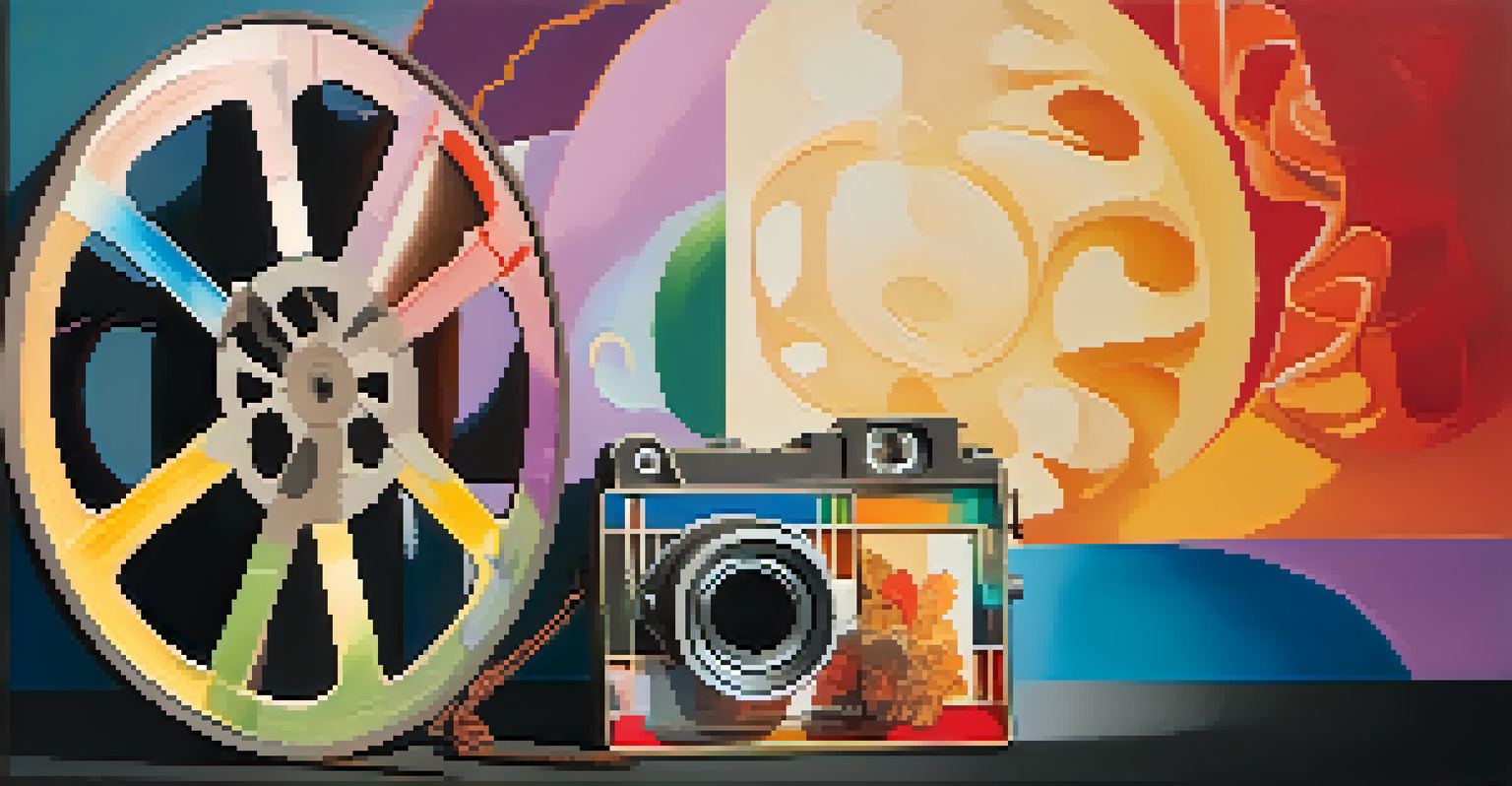Cross-Cultural Collaborations: Hollywood and Global Filmmakers

The Rise of Global Filmmaking in Hollywood
In recent years, Hollywood has increasingly embraced global filmmaking, which has transformed the industry landscape. This shift is largely driven by the recognition of diverse narratives and international audiences that crave representation on screen. Filmmakers from various countries are now collaborating with Hollywood studios to create content that resonates across cultures.
Diversity is not a reason for division, but a reason for collaboration.
For example, films like 'Parasite' and 'Crouching Tiger, Hidden Dragon' have not only achieved critical acclaim but also demonstrated the commercial viability of cross-cultural projects. By incorporating different storytelling techniques and cultural nuances, these films have broadened the scope of what Hollywood can offer. This trend signifies a growing appreciation for global perspectives in mainstream cinema.
As a result, Hollywood is not just exporting its films; it’s also becoming a melting pot of ideas, styles, and cultural expressions. This collaborative spirit fosters creativity and innovation, making way for stories that reflect a more interconnected world. The success of such collaborations illustrates the power of diverse voices in shaping cinematic history.
Cultural Exchange: Learning from Each Other
Cross-cultural collaborations offer a unique opportunity for filmmakers to learn from one another’s traditions and techniques. When filmmakers from different backgrounds come together, they exchange valuable insights about their respective cultures, enhancing the storytelling process. This cultural exchange can lead to richer narratives that appeal to a global audience.

For instance, the collaboration between Hollywood and Indian filmmakers has resulted in vibrant films that blend Bollywood's musical flair with Hollywood's storytelling prowess. Such partnerships allow filmmakers to experiment with new styles and genres, ultimately pushing the boundaries of creativity. As they share their artistic practices, they pave the way for innovative storytelling.
Global Filmmaking Transforms Hollywood
Hollywood is increasingly collaborating with international filmmakers, enriching the industry with diverse narratives and perspectives.
Moreover, these collaborations can foster mutual respect and understanding among diverse cultures. As filmmakers immerse themselves in one another’s worlds, they create a bridge that connects audiences from different backgrounds. This not only enriches the viewing experience but also promotes a sense of unity through shared stories.
Challenges in Cross-Cultural Collaborations
Despite the benefits, cross-cultural collaborations are not without their challenges. Language barriers, differing cultural norms, and distinct filmmaking practices can complicate the creative process. Filmmakers must navigate these hurdles to ensure that the final product authentically represents the various cultures involved.
Film is a universal language; it can cross borders and connect cultures.
For example, subtle nuances in humor or social customs can lead to misunderstandings if not addressed appropriately. It's essential for collaborators to engage in open communication and cultural sensitivity to bridge these gaps. By doing so, they can create films that honor the integrity of each culture while still appealing to a broader audience.
Additionally, there can be concerns about cultural appropriation, where one culture's elements are used without proper context or respect. To combat this, filmmakers must prioritize collaboration with local talent and ensure that the stories they tell are authentic and respectful. This commitment to authenticity helps build trust and credibility among audiences.
The Impact of Technology on Film Collaboration
Advancements in technology have significantly influenced cross-cultural collaborations in filmmaking. The rise of digital communication tools and online platforms allows filmmakers from around the globe to connect and collaborate seamlessly. This has made it easier for diverse voices to contribute to projects, regardless of geographical barriers.
For instance, virtual reality (VR) and augmented reality (AR) technologies have opened new avenues for storytelling, enabling filmmakers to create immersive experiences. These tools can enhance the narrative by allowing audiences to engage with different cultures in innovative ways. As a result, filmmakers can share their stories more effectively across borders.
Cultural Exchange Enhances Storytelling
Cross-cultural collaborations allow filmmakers to learn from each other's traditions, leading to richer narratives that resonate globally.
Moreover, the accessibility of production and editing software has democratized filmmaking, empowering emerging talents from various backgrounds. This shift encourages a broader range of perspectives in the industry, ultimately enriching the cinematic landscape. Technology continues to play a crucial role in fostering collaboration and creativity among global filmmakers.
Success Stories of Cross-Cultural Collaborations
Several successful films exemplify the potential of cross-cultural collaborations, showcasing the beauty of diverse storytelling. One notable example is 'The Farewell,' directed by Lulu Wang, which beautifully blends American and Chinese cultural elements to tell a poignant family story. The film resonates with audiences worldwide, illustrating how cultural nuances can transcend borders.
Another inspiring collaboration is 'Slumdog Millionaire,' which combined Indian storytelling with British filmmaking. The film's success not only brought attention to Indian cinema but also highlighted the richness of India's cultural landscape. Such success stories demonstrate the power of collaboration in creating universally relatable narratives.
These films not only achieve commercial success but also foster conversations about cultural identity and representation. By breaking down barriers, these collaborations inspire future filmmakers to explore new horizons. Ultimately, they show that great storytelling knows no boundaries.
The Future of Cross-Cultural Collaborations
Looking ahead, the future of cross-cultural collaborations in filmmaking appears bright. As globalization continues to connect people, filmmakers are increasingly motivated to tell diverse stories that reflect our shared human experience. The industry is recognizing the value of inclusion, paving the way for more collaborative projects that celebrate cultural diversity.
With streaming platforms gaining popularity, there's a growing demand for international content. This trend encourages filmmakers to seek partnerships beyond their local markets, fostering a spirit of collaboration. As a result, audiences can expect to see an influx of innovative cross-cultural films that challenge traditional storytelling norms.
Technology Fuels Film Collaboration
Advancements in technology facilitate seamless connections between filmmakers worldwide, democratizing the creative process and broadening perspectives.
Ultimately, the evolution of cross-cultural collaborations promises to enrich the cinematic landscape. By embracing diversity and celebrating different perspectives, filmmakers can create stories that resonate with audiences worldwide. This approach not only enhances creativity but also strengthens the global film community.
Conclusion: Celebrating Diversity in Filmmaking
In conclusion, cross-cultural collaborations between Hollywood and global filmmakers are reshaping the film industry. By embracing diverse voices and perspectives, filmmakers can create richer, more compelling stories that resonate with audiences around the world. This shift not only celebrates cultural diversity but also fosters understanding and empathy across borders.
As we continue to witness the impact of these collaborations, it is essential to support and promote inclusive storytelling. Encouraging filmmakers from various backgrounds to share their experiences will only enhance the cinematic landscape. This commitment to diversity will ensure that future generations have access to a rich tapestry of stories.

Ultimately, the journey of cross-cultural collaboration is about more than just film; it's about connection, understanding, and celebrating the unique stories that each culture has to offer. As filmmakers come together, they create a vibrant narrative that reflects the beauty of our shared humanity.